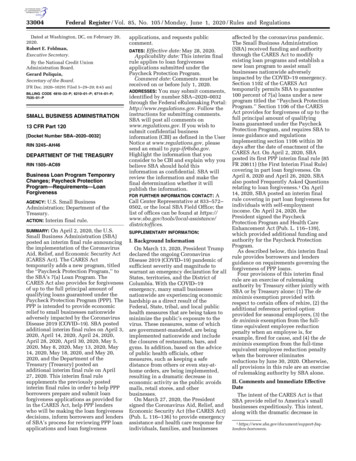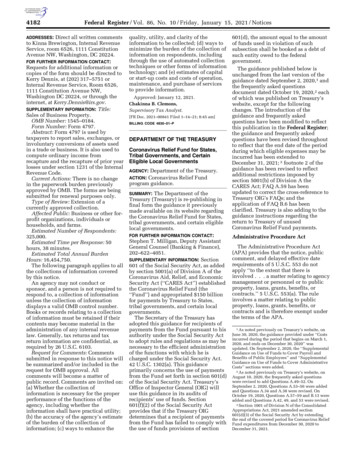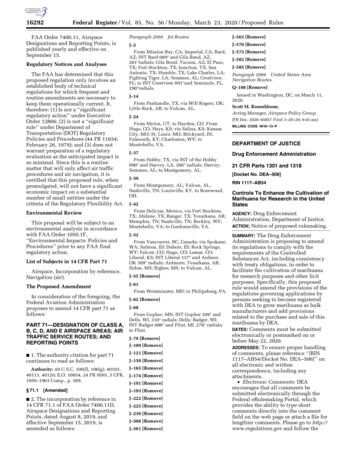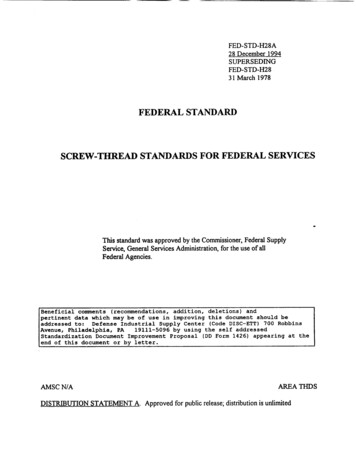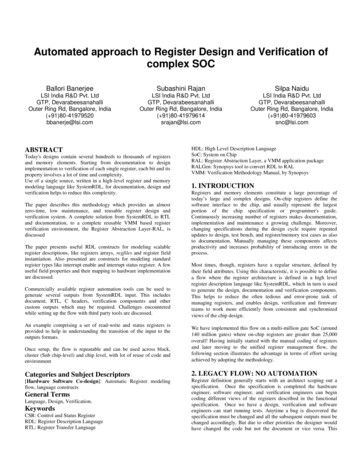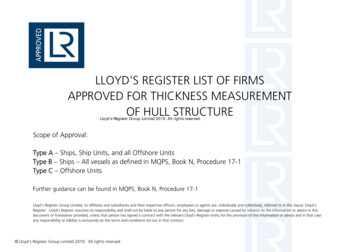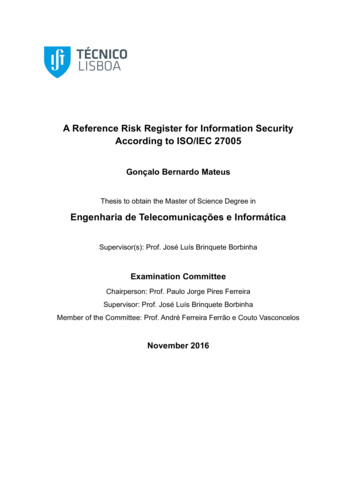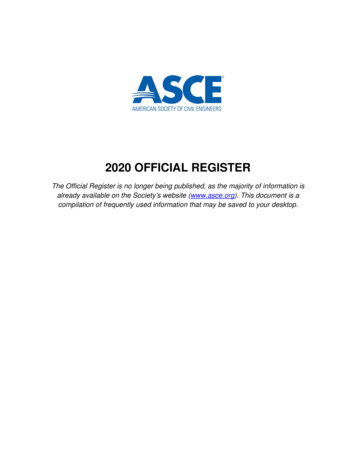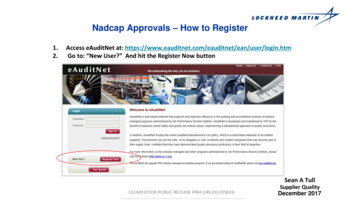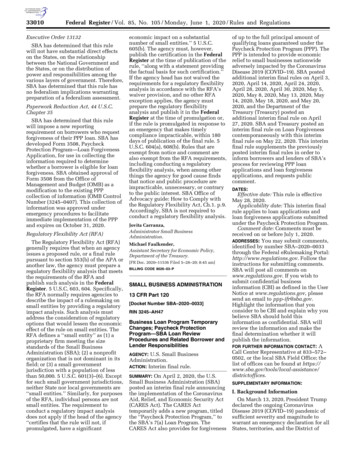
Transcription
33010Federal Register / Vol. 85, No. 105 / Monday, June 1, 2020 / Rules and RegulationsExecutive Order 13132SBA has determined that this rulewill not have substantial direct effectson the States, on the relationshipbetween the National Government andthe States, or on the distribution ofpower and responsibilities among thevarious layers of government. Therefore,SBA has determined that this rule hasno federalism implications warrantingpreparation of a federalism assessment.Paperwork Reduction Act, 44 U.S.C.Chapter 35SBA has determined that this rulewill impose a new reportingrequirement on borrowers who requestforgiveness of their PPP loan. SBA hasdeveloped Form 3508, PaycheckProtection Program—Loan ForgivenessApplication, for use in collecting theinformation required to determinewhether a borrower is eligible for loanforgiveness. SBA obtained approval ofForm 3508 from the Office ofManagement and Budget (OMB) as amodification to the existing PPPcollection of information (OMB ControlNumber (3245–0407). This collection ofinformation was approved underemergency procedures to facilitateimmediate implementation of the PPPand expires on October 31, 2020.jbell on DSKJLSW7X2PROD with RULESRegulatory Flexibility Act (RFA)The Regulatory Flexibility Act (RFA)generally requires that when an agencyissues a proposed rule, or a final rulepursuant to section 553(b) of the APA oranother law, the agency must prepare aregulatory flexibility analysis that meetsthe requirements of the RFA andpublish such analysis in the FederalRegister. 5 U.S.C. 603, 604. Specifically,the RFA normally requires agencies todescribe the impact of a rulemaking onsmall entities by providing a regulatoryimpact analysis. Such analysis mustaddress the consideration of regulatoryoptions that would lessen the economiceffect of the rule on small entities. TheRFA defines a ‘‘small entity’’ as (1) aproprietary firm meeting the sizestandards of the Small BusinessAdministration (SBA); (2) a nonprofitorganization that is not dominant in itsfield; or (3) a small governmentjurisdiction with a population of lessthan 50,000. 5 U.S.C. 601(3)–(6). Exceptfor such small government jurisdictions,neither State nor local governments are‘‘small entities.’’ Similarly, for purposesof the RFA, individual persons are notsmall entities. The requirement toconduct a regulatory impact analysisdoes not apply if the head of the agency‘‘certifies that the rule will not, ifpromulgated, have a significantVerDate Sep 11 201416:09 May 29, 2020Jkt 250001economic impact on a substantialnumber of small entities.’’ 5 U.S.C.605(b). The agency must, however,publish the certification in the FederalRegister at the time of publication of therule, ‘‘along with a statement providingthe factual basis for such certification.’’If the agency head has not waived therequirements for a regulatory flexibilityanalysis in accordance with the RFA’swaiver provision, and no other RFAexception applies, the agency mustprepare the regulatory flexibilityanalysis and publish it in the FederalRegister at the time of promulgation or,if the rule is promulgated in response toan emergency that makes timelycompliance impracticable, within 180days of publication of the final rule. 5U.S.C. 604(a), 608(b). Rules that areexempt from notice and comment arealso exempt from the RFA requirements,including conducting a regulatoryflexibility analysis, when among otherthings the agency for good cause findsthat notice and public procedure areimpracticable, unnecessary, or contraryto the public interest. SBA Office ofAdvocacy guide: How to Comply withthe Regulatory Flexibility Act, Ch.1. p.9.Accordingly, SBA is not required toconduct a regulatory flexibility analysis.Jovita Carranza,Administrator Small BusinessAdministration.Michael Faulkender,Assistant Secretary for Economic Policy,Department of the Treasury.[FR Doc. 2020–11536 Filed 5–28–20; 8:45 am]BILLING CODE 8026–03–PSMALL BUSINESS ADMINISTRATION13 CFR Part 120[Docket Number SBA–2020–0033]RIN 3245–AH47Business Loan Program TemporaryChanges; Paycheck ProtectionProgram—SBA Loan ReviewProcedures and Related Borrower andLender ResponsibilitiesU.S. Small BusinessAdministration.ACTION: Interim final rule.AGENCY:On April 2, 2020, the U.S.Small Business Administration (SBA)posted an interim final rule announcingthe implementation of the CoronavirusAid, Relief, and Economic Security Act(CARES Act). The CARES Acttemporarily adds a new program, titledthe ‘‘Paycheck Protection Program,’’ tothe SBA’s 7(a) Loan Program. TheCARES Act also provides for forgivenessSUMMARY:PO 00000Frm 00034Fmt 4700Sfmt 4700of up to the full principal amount ofqualifying loans guaranteed under thePaycheck Protection Program (PPP). ThePPP is intended to provide economicrelief to small businesses nationwideadversely impacted by the CoronavirusDisease 2019 (COVID–19). SBA postedadditional interim final rules on April 3,2020, April 14, 2020, April 24, 2020,April 28, 2020, April 30, 2020, May 5,2020, May 8, 2020, May 13, 2020, May14, 2020, May 18, 2020, and May 20,2020, and the Department of theTreasury (Treasury) posted anadditional interim final rule on April27, 2020. SBA and Treasury posted aninterim final rule on Loan Forgivenesscontemporaneously with this interimfinal rule on May 22, 2020. This interimfinal rule supplements the previouslyposted interim final rules in order toinform borrowers and lenders of SBA’sprocess for reviewing PPP loanapplications and loan forgivenessapplications, and requests publiccomment.DATES:Effective date: This rule is effectiveMay 28, 2020.Applicability date: This interim finalrule applies to loan applications andloan forgiveness applications submittedunder the Paycheck Protection Program.Comment date: Comments must bereceived on or before July 1, 2020.ADDRESSES: You may submit comments,identified by number SBA–2020–0033through the Federal eRulemaking Portal:http://www.regulations.gov. Follow theinstructions for submitting comments.SBA will post all comments onwww.regulations.gov. If you wish tosubmit confidential businessinformation (CBI) as defined in the UserNotice at www.regulations.gov, pleasesend an email to ppp-ifr@sba.gov.Highlight the information that youconsider to be CBI and explain why youbelieve SBA should hold thisinformation as confidential. SBA willreview the information and make thefinal determination whether it willpublish the information.FOR FURTHER INFORMATION CONTACT: ACall Center Representative at 833–572–0502, or the local SBA Field Office; thelist of offices can be found at toffices.SUPPLEMENTARY INFORMATION:I. Background InformationOn March 13, 2020, President Trumpdeclared the ongoing CoronavirusDisease 2019 (COVID–19) pandemic ofsufficient severity and magnitude towarrant an emergency declaration for allStates, territories, and the District ofE:\FR\FM\01JNR1.SGM01JNR1
jbell on DSKJLSW7X2PROD with RULESFederal Register / Vol. 85, No. 105 / Monday, June 1, 2020 / Rules and RegulationsColumbia. With the COVID–19emergency, many small businessesnationwide are experiencing economichardship as a direct result of theFederal, State, tribal, and local publichealth measures that are being taken tominimize the public’s exposure to thevirus. These measures, some of whichare government-mandated, are beingimplemented nationwide and includethe closures of restaurants, bars, andgyms. In addition, based on the adviceof public health officials, othermeasures, such as keeping a safedistance from others or even stay-athome orders, are being implemented,resulting in a dramatic decrease ineconomic activity as the public avoidsmalls, retail stores, and otherbusinesses.On March 27, 2020, the Presidentsigned the Coronavirus Aid, Relief, andEconomic Security Act (the CARES Act)(Pub. L. 116–136) to provide emergencyassistance and health care response forindividuals, families, and businessesaffected by the coronavirus pandemic.The Small Business Administration(SBA) received funding and authoritythrough the CARES Act to modifyexisting loan programs and establish anew loan program to assist smallbusinesses nationwide adverselyimpacted by the COVID–19 emergency.Section 1102 of the CARES Acttemporarily permits SBA to guarantee100 percent of 7(a) loans under a newprogram titled the ‘‘Paycheck ProtectionProgram.’’ Section 1106 of the CARESAct provides for forgiveness of up to thefull principal amount of qualifyingloans guaranteed under the PaycheckProtection Program, and requires SBA toissue guidance and regulationsimplementing section 1106 within 30days after the date of enactment of theCARES Act. On April 2, 2020, SBAposted its first PPP interim final rule (85FR 20811) (the First Interim Final Rule)covering in part loan forgiveness. OnApril 8, 2020 and on April 26, 2020,SBA posted Frequently AskedQuestions on loan forgiveness.1 OnApril 14, 2020, SBA posted another PPPinterim final rule (85 FR 21747)covering in part loan forgiveness. OnApril 24, 2020, the President signed thePaycheck Protection Program andHealth Care Enhancement Act (Pub. L.116–139), which provided additionalfunding and authority for the PaycheckProtection Program.As described below, this interim finalrule informs borrowers and lenders ofSBA’s process for reviewing PPP loanapplications and loan forgiveness1 rrowers.VerDate Sep 11 201416:09 May 29, 2020Jkt 250001applications. This interim final rulesupplements the interim final rule onLoan Forgiveness postedcontemporaneously with this interimfinal rule.II. Comments and Immediate EffectiveDateThe intent of the CARES Act is thatSBA provide relief to America’s smallbusinesses expeditiously. This intent,along with the dramatic decrease ineconomic activity nationwide, providesgood cause for SBA to dispense with the30-day delayed effective date providedin the Administrative Procedure Act.Specifically, it is critical to meetlenders’ and borrowers’ need for clarityconcerning loan forgivenessrequirements as rapidly as possiblebecause borrowers can seek loanforgiveness as early as eight-weeksfollowing the date of disbursement oftheir PPP loans. Because the first PPPloans were disbursed after April 3,providing borrowers with certainty onSBA’s process for reviewing PPP loanapplications and loan forgivenessapplications will enhance borrowers’ability to determine whether, and towhat extent, they should apply for PPPloans and loan forgiveness, and therebycarry out the purposes of the CARES Actin keeping their workers employed andpaid, while at the same time takingnecessary steps to maximize eligibleloan forgiveness amounts. Animmediate effective date also isnecessary for PPP lenders who generallywill make the loan forgivenessdeterminations, as provided in theCARES Act. Specifically, an immediateeffective date is necessary for lenders sothat they will have both a degree ofcertainty and sufficient time to developtheir systems and policies andprocedures in order to timely processloan forgiveness applications.This interim final rule supplementsprevious regulations and guidance onthe discrete issues related to SBA’sprocess for review of PPP loanapplications and loan forgivenessapplications. This interim final rule iseffective without advance notice andpublic comment because section 1114 ofthe CARES Act authorizes SBA to issueregulations to implement Title I of theCARES Act without regard to noticerequirements. In addition, SBA hasdetermined that there is good cause fordispensing with advance public noticeand comment on the ground that itwould be contrary to the public interest.Specifically, SBA has determined thatadvance notice and public commentwould delay the ability of PPPborrowers to understand with certaintySBA’s process for reviewing PPP loanPO 00000Frm 00035Fmt 4700Sfmt 470033011applications and loan forgivenessapplications. By providing a high degreeof certainty to PPP borrowers throughthis interim final rule, PPP borrowerswill be able to take immediate steps tomaximize their loan forgivenessamounts. This rule is being issued toallow for immediate implementation ofthe forgiveness component of thisprogram. Although this interim finalrule is effective immediately, commentsare solicited from interested members ofthe public on all aspects of this interimfinal rule, including section III below.These comments must be submitted onor before July 1, 2020. SBA willconsider these comments and the needfor making any revisions as a result ofthese comments.III. Paycheck Protection ProgramRequirements for SBA Loan ReviewProcedures and Related Borrower andLender ResponsibilitiesOverviewThe CARES Act was enacted toprovide immediate assistance toindividuals, families, and organizationsaffected by the COVID–19 emergency.Among the provisions contained in theCARES Act are provisions authorizingSBA to temporarily guarantee loansunder the Paycheck Protection Program(PPP). Loans under the PPP will be 100percent guaranteed by SBA, and the fullprincipal amount of the loans mayqualify for loan forgiveness. Additionalinformation about the PPP is availablein interim final rules published by SBAand Treasury in the Federal Register (85FR 20811, 85 FR 20817, 85 FR 21747,85 FR 23450, 85 FR 23917, 85 FR 26321,85 FR 26324, 85 FR 27287, 85 FR 29842,85 FR 29845, 85 FR 29847, 85 FR30835), as well as an SBA interim finalrule posted on May 20, 2020 and anSBA and Treasury interim final ruleposted on May 22, 2020 (collectively,the PPP Interim Final Rules).Under the CARES Act, SBA isauthorized to guarantee loans under thePPP, a new temporary 7(a) program,through June 30, 2020. The intent of theAct is that SBA provide relief toAmerica’s small businessesexpeditiously, which is expressed in theAct by giving all lenders delegatedauthority and streamlining therequirements of the regular 7(a) loanprogram.The Small Business Act authorizesthe Administrator to conductinvestigations to determine whether arecipient or participant in anyassistance under a 7(a) pr
33010 Federal Register/Vol. 85, No. 105/Monday, June 1, 2020/Rules and Regulations Executive Order 13132 SBA has determined that this rule will not have substantial
